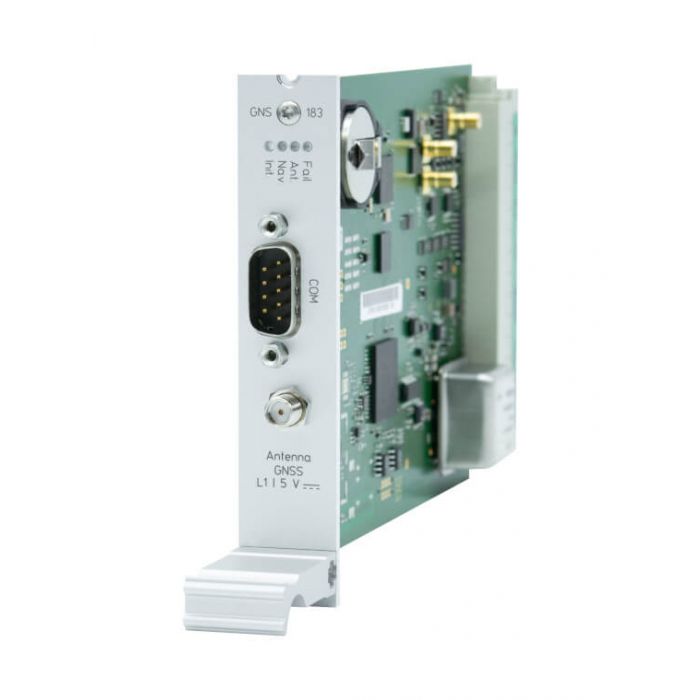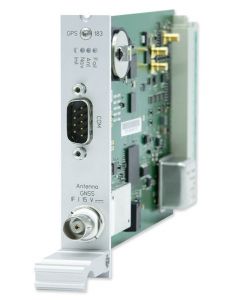
GNS183
GNS183
Meinberg
Clock Module with Multi-GNSS Receiver for GPS, Galileo, GLONASS, and BeiDou
IMS-RSC: Switch Module for Seamless Switchover of Backplane Signals
The IMS-GNS is a 72-channel satellite clock module with GNSS technology that has been developed from the ground up specifically for time and frequency synchronisation purposes. The IMS-GNS provides a high-precision, high-accuracy time and frequency reference for your Meinberg IMS system and is designed to receive signals from the U.S. Global Positioning System (GPS), the European Galileo system, the Chinese BeiDou system, and the Russian GLONASS system, providing an impressive range of sources for your Meinberg system to be used anywhere in the world.
How the Meinberg IMS-GNS works
The integrated GNSS receiver requires an external Multi-GNSS L1 antenna to receive signals from GPS, Galileo, BeiDou, and GLONASS satellites.
Once the IMS-GNS is successfully initialised and synchronised, it distributes a 1PPS (pulse-per-second) reference clock signal and a 10 MHz reference frequency. These are then used by the IMS output modules to generate a wide variety of specific output signals used in a diverse range of applications. The precision and accuracy of the two aforementioned reference signals are critical in determining the corresponding precision and accuracy of the output signals.
The module also supports the IMS platform's MRS functionality (Multi Reference Source) to utilise all available reference sources for synchronisation beyond the GNSS signals.
The IMS-GNS module is hot-swappable and is automatically detected and utilised when installed, even while the system is still in operations
Use of Two IMS Receiver Modules
In systems equipped with two redundant IMS receiver modules, an RSC switchover module is used to switch between the two reference sources. The RSC serves to switch over the pulse and frequency outputs and serial interfaces of the connected reference clocks.
Click below to request a quote for this item. Or for product advice, stock and lead time enquiries call our team on 0330 313 3220.
| Attribute | Value |
|---|---|
| Key Features |
|
| Current Draw | 1.1 A to 1.4 A (depends on oscillator option) |
| Humidity | Max. 85 % (non-condensing) at 40 °C |
| Interface | RS-232 interface for time string output and also for synchronization using time string input and PPS signal |
| Frequency Outputs | 0.125 Hz - 10 MHz |
| Pulse outputs | Various programmable pulse signals (TTL levels), including pulse-per-second and pulse-per-minute, outputs over four discrete channels, delivery via external output modules |
| Accuracy of Pulse Outputs | Depends on oscillator option: < ±100ns (TCXO, OCXO LQ) < ±50ns (OCXO SQ, OCXO MQ, OCXO HQ, OCXO DHQ, Rubidium) |
| Type of Antenna | Included 40 dB L1 Multi-GNSS antenna |
| Synchronisation Time | Max. 1 minute in normal operating conditions Max. 25 minutes (average 12 minutes) upon first initialization or in the absence of saved satellite data |
| Frequency Inputs | 1561.098 MHz (BeiDou B1I) 1575.420 MHz (GPS L1 C/A, Galileo E1-B/C) 1602.000 - 1602.563 MHz (GLONASS L1OF) |
| Backup Battery Type | CR2032 (lithium button cell) |
| Accuracy of Frequency Outputs | Accuracy dependent on oscillator |
| Receiver | 72-channel GPS L1 / Galileo E1 / GLONASS L1OF / BeiDou B1I receiver |
| Attribute | Value |
|---|---|
| Data Sheet | Click here to view |



